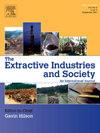Life cycle assessment of iron ore in Brazil: The importance of system boundaries
IF 3.6
2区 社会学
Q2 ENVIRONMENTAL STUDIES
Extractive Industries and Society-An International Journal
Pub Date : 2024-09-24
DOI:10.1016/j.exis.2024.101541
引用次数: 0
Abstract
This study adopts life cycle analysis tools to estimate greenhouse gas (GHG) emissions from Brazil's iron ore sector. It is based on the assumption that when commodities are extracted strictly for export, ignoring the impacts of logistics might undervalue these products’ contribution to climate change. Therefore, we calculate the emissions associated with land use change, mining, ore processing, pelletisation, land transport, and international shipping. Iron ore is used as the case study because it is the most traded metal in the global market. This research is grounded in secondary data obtained from public databases of Brazilian agencies for the 2016–2020 period. When reliable information is unavailable, the Ecoinvent database is used and adjusted for the Brazilian context. This study evaluates the emissions of one tonne of iron ore and pellets. Estimates indicate that deforestation/land use, mining and processing, domestic transport, pellet production, and international shipping represent 9 %, 38 %, 11 %, 13 %, and 29 % of the GHG emissions of Brazil's iron ore sector, respectively.
巴西铁矿石的生命周期评估:系统边界的重要性
本研究采用生命周期分析工具来估算巴西铁矿石行业的温室气体排放量。它基于这样一个假设:当商品的开采完全是为了出口时,忽略物流的影响可能会低估这些产品对气候变化的影响。因此,我们计算了与土地利用变化、采矿、矿石加工、球团化、陆路运输和国际航运相关的排放量。铁矿石是全球市场上交易量最大的金属,因此被用作案例研究。本研究以从巴西机构的公共数据库中获取的 2016-2020 年期间的二手数据为基础。如果无法获得可靠信息,则使用 Ecoinvent 数据库,并根据巴西国情进行调整。本研究评估了一吨铁矿石和球团矿的排放量。据估计,森林砍伐/土地使用、采矿和加工、国内运输、球团生产和国际运输分别占巴西铁矿石行业温室气体排放量的 9%、38%、11%、13% 和 29%。
本文章由计算机程序翻译,如有差异,请以英文原文为准。
求助全文
约1分钟内获得全文
求助全文
来源期刊

Extractive Industries and Society-An International Journal
ENVIRONMENTAL STUDIES-
CiteScore
6.60
自引率
19.40%
发文量
135
 求助内容:
求助内容: 应助结果提醒方式:
应助结果提醒方式:


